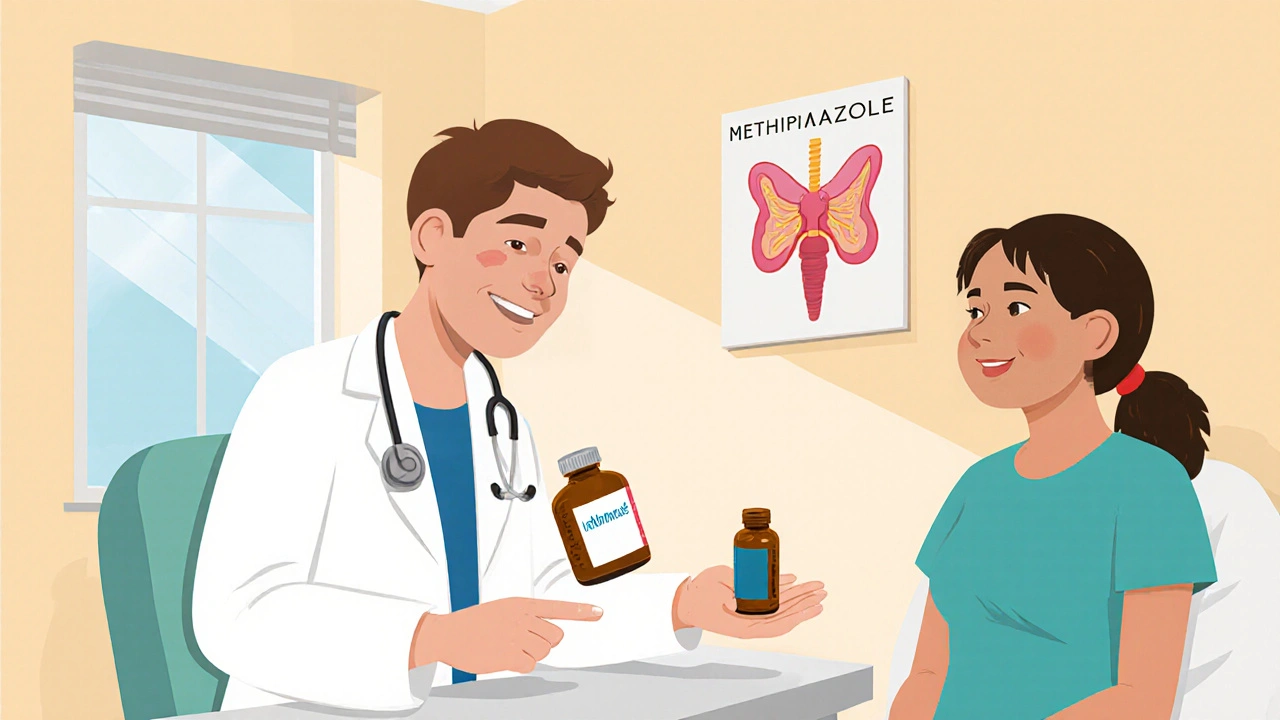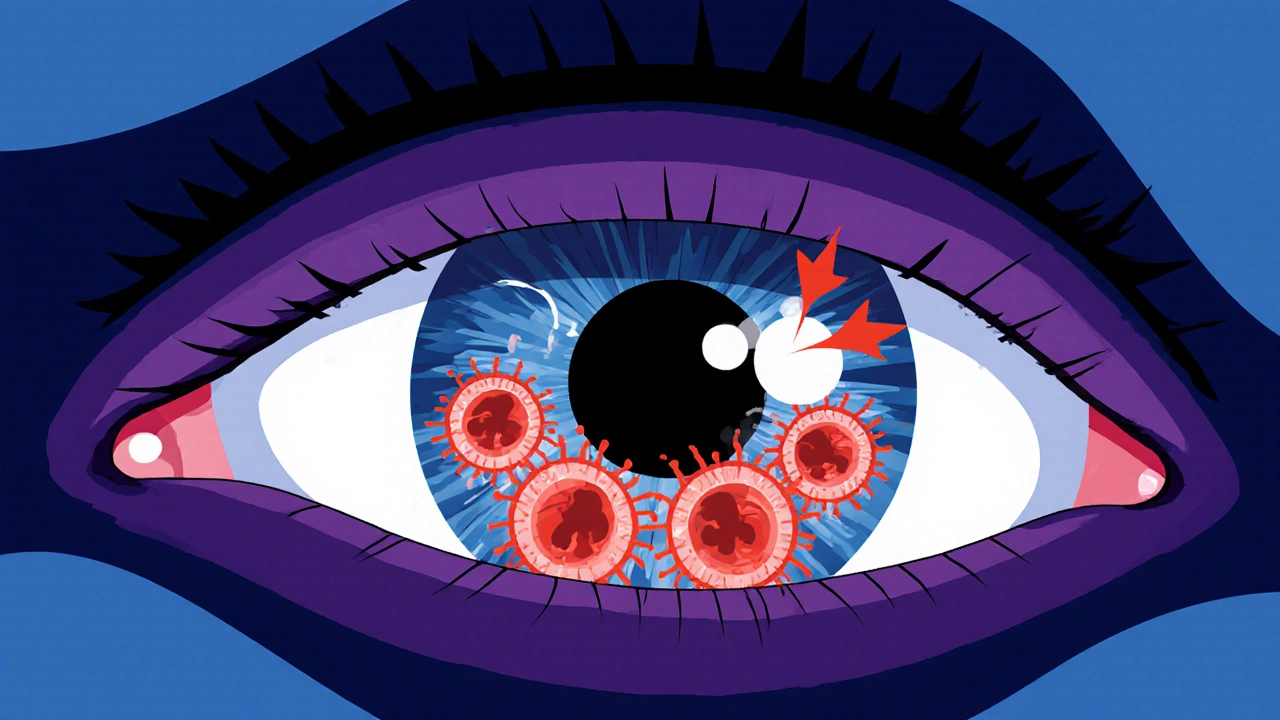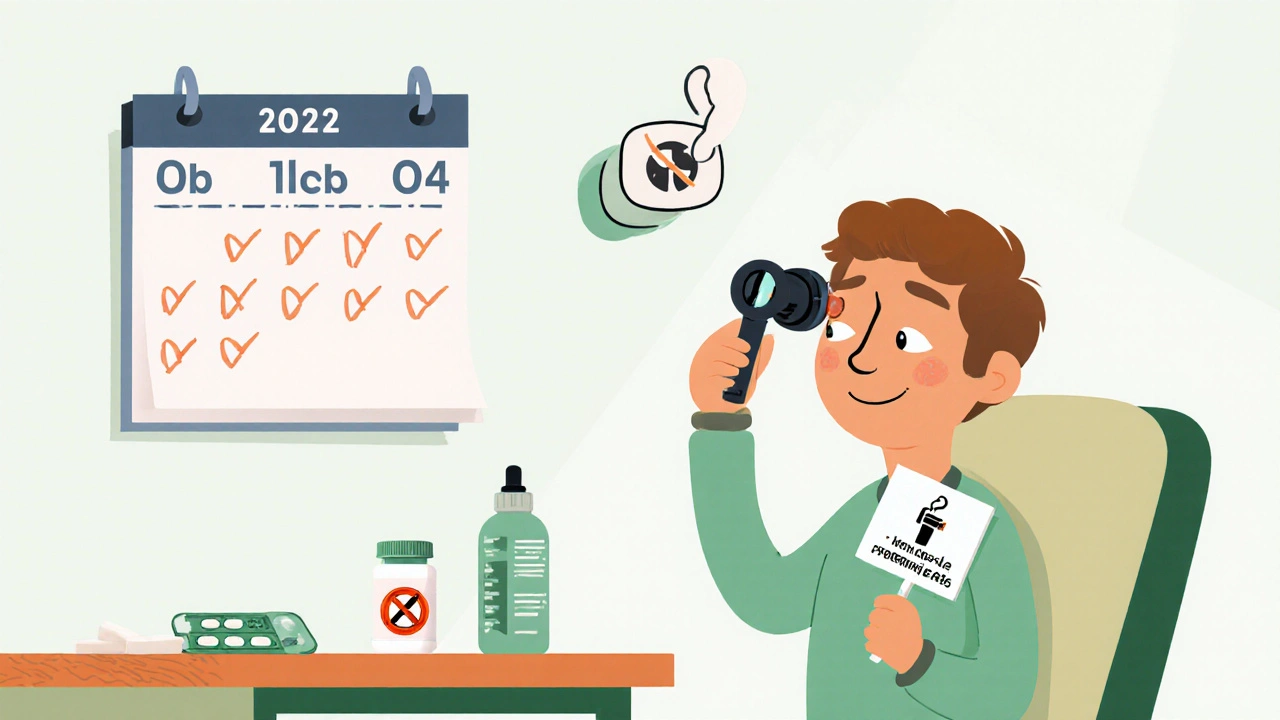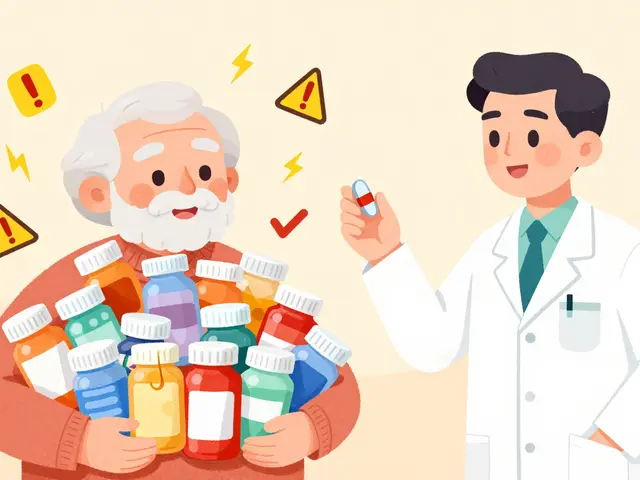
Key Takeaways
- Methimazole is the first‑line antithyroid drug for most patients with Graves disease.
- Thyroid Eye Disease (TED) can improve, stay stable, or worsen depending on how well thyroid function is controlled.
- Monitoring eye signs every 3‑6 months is essential, especially during the first two years of treatment.
- Adjuncts such as selenium, low‑dose steroids, or orbital radiotherapy may be needed when eye disease is active.
- Switching to propylthiouracil or proceeding to definitive therapy (radioactive iodine or surgery) is considered if methimazole fails or causes side effects.
What Is Methimazole?
Methimazole is a potent thionamide that inhibits thyroid peroxidase, thereby blocking the synthesis of thyroid hormones T3 and T4. It was first approved in the 1950s and quickly became the preferred oral antithyroid medication in most Western countries. Compared with its older cousin propylthiouracil, methimazole has a longer half‑life, requires only once‑daily dosing, and carries a lower risk of severe liver injury.
Understanding Thyroid Eye Disease (TED)
Thyroid Eye Disease is an autoimmune inflammation of the orbital tissues that commonly accompanies Graves disease. When the immune system attacks the fibroblasts behind the eye, they swell, pull the eye forward, and may cause double vision, gritty sensation, or even vision‑threatening optic nerve compression. About 30‑40 % of patients with Graves disease develop some degree of eye involvement, but only a minority (5‑10 %) need aggressive treatment.
How Methimazole Affects the Eyes
Controlling thyroid hormone levels is the first step in halting the cascade that drives orbital inflammation. Studies from 2022‑2024 show that patients who achieve euthyroidism within three months of starting methimazole have a 40 % lower chance of TED progression compared with delayed control.
Mechanistically, methimazole reduces the antigenic stimulus (excess TSH‑receptor antibodies) that fuels orbital fibroblast activation. However, the drug does not directly suppress the inflammatory cytokines (IL‑6, TNF‑α) that cause tissue swelling. Therefore, while many patients see their eye symptoms stabilize, a subset will need additional therapy.

When to Expect Improvement, Stabilization, or Worsening
- Improvement: Usually seen in patients with mild (class 1‑2) disease who attain euthyroidism quickly and have low TSH‑receptor antibody titres.
- Stabilization: Most common outcome; eye signs stop getting worse but may not fully recede. This scenario often occurs in moderate (class 3‑4) disease.
- Worsening: Can happen if thyroid function fluctuates, if high‑dose steroids are tapered too fast, or if the patient smokes.
Key predictors of a poor ocular course include smoking, high baseline antibody levels, and a rapid rise in thyroid hormone after radioactive iodine (RAI) therapy.
Monitoring Strategies
Regular ophthalmic assessment is a must. Here’s a practical schedule:
- Baseline: Full orbital exam, visual acuity, intra‑ocular pressure, and exophthalmometry.
- Every 3 months (first year): Repeat the exam, especially if symptoms change.
- Every 6 months (years 2‑3): Continue until disease is inactive for at least six months.
Document changes using the Clinical Activity Score (CAS) - a 7‑point scale that captures redness, swelling, pain, and impaired function. A CAS ≥ 3 signals active disease that may benefit from adjunctive treatment.
Adjunctive Therapies for Active TED
When methimazole alone isn’t enough, clinicians add one or more of the following:
- Selenium is a trace mineral with antioxidant properties that modestly reduces inflammation in mild TED. A 100 µg daily supplement for six months is recommended by many endocrinology societies.
- Corticosteroids systemic or intravenous steroids quickly dampen orbital inflammation. Low‑dose oral prednisone (0.5 mg/kg) tapered over 3‑6 months is typical for moderate disease.
- Orbital radiotherapy delivers focused low‑dose radiation to the retro‑orbital tissues, limiting fibroblast proliferation. Often combined with steroids for severe, steroid‑responsive cases.
- Surgical decompression relieves optic nerve compression and reduces proptosis in late‑stage disease. Reserved for sight‑threatening or cosmetically severe cases after the disease has been inactive for at least 6‑12 months.

Alternative Antithyroid Options
If methimazole causes adverse effects (agranulocytosis, rash, hepatic dysfunction) or fails to control hormones, clinicians consider:
| Strategy | Typical Dose | Key Benefits | Common Side Effects |
|---|---|---|---|
| Methimazole | 10‑30 mg daily | Once‑daily, low hepatotoxicity | Agranulocytosis (rare), skin rash |
| Propylthiouracil (PTU) | 100‑300 mg daily | Preferred in first trimester pregnancy | Higher risk of liver injury, agranulocytosis |
| Radioactive Iodine (RAI) | 10‑30 mCi (single dose) | Definitive, no daily meds | Can worsen TED (especially smokers) |
| Thyroidectomy | Surgical removal | Immediate control, no radiation | Operative risks, need for lifelong levothyroxine |
When RAI is chosen, prophylactic steroids (0.5 mg/kg prednisone for 1-2 weeks) blunt the post‑RAI surge in antibodies that could aggravate the eyes.
Practical Tips for Clinicians and Patients
- **Never** discontinue methimazole abruptly without an alternative plan; a sudden hormone swing can trigger a TED flare.
- Encourage smoking cessation - smokers have a 2‑3× higher risk of severe eye disease.
- Check complete blood count weekly for the first month, then monthly, to catch agranulocytosis early.
- Ask patients about new eye symptoms (dryness, double vision, pain) at each visit.
- Consider baseline selenium status; low levels are common in iodine‑deficient regions.
Frequently Asked Questions
Can methimazole cure thyroid eye disease?
No. Methimazole controls the thyroid hormone excess that fuels the autoimmune response, but it does not directly eliminate orbital inflammation. Eye disease may improve, stay the same, or worsen depending on other factors.
How long should I stay on methimazole if I have TED?
Most patients need 12‑18 months of therapy to achieve stable thyroid function. Some continue longer if remission is incomplete or if they prefer to avoid definitive treatment.
Is it safe to combine methimazole with steroids?
Yes. Steroids target ocular inflammation while methimazole normalizes thyroid hormones. Close monitoring for infection and blood pressure is advised.
What should I do if I develop a rash while on methimazole?
Contact your doctor immediately. Mild rashes may be harmless, but severe or widespread eruptions can signal an allergic reaction requiring discontinuation.
Are there any dietary restrictions while taking methimazole?
No strict bans, but keep iodine intake moderate. Excess iodine (e.g., kelp supplements) can provoke thyroid hormone spikes.
Next Steps for Readers
If you’re starting methimazole and notice any change in eye shape, pressure, or vision, schedule an ophthalmology appointment within two weeks. For clinicians, integrating a shared decision‑making tool that balances the risks of medication versus definitive therapy can streamline patient counseling.
Remember, controlling the thyroid is only half the battle; proactive eye care and lifestyle tweaks (no smoking, adequate selenium) often make the difference between a mild cosmetic issue and a sight‑threatening emergency.






10 Comments
Methimazole remains the cornerstone-its pharmacokinetics, once‑daily dosing, and reduced hepatic risk make it the preferred choice; however, you must remember that ocular outcomes hinge on more than thyroid hormone levels; the article rightly emphasizes regular ophthalmic monitoring, the CAS score, and smoking cessation; patients often underestimate the impact of even mild exophthalmos on quality of life; clinicians should therefore integrate eye exams into every endocrine visit; while adjuncts such as selenium and low‑dose steroids provide incremental benefit, they are not substitutes for euthyroidism; the guide also correctly notes the potential for RAI‑induced worsening, especially in smokers; overall, the balanced approach presented aligns with contemporary guidelines; keep an eye on lab trends and visual symptoms alike.
I appreciate the comprehensive nature of this guide-its structured monitoring schedule is exemplary, and the inclusion of both clinical and patient‑focused recommendations reflects best practice. 😊 The emphasis on baseline CAS assessment, followed by 3‑month intervals during the first year, provides a clear roadmap for clinicians. Additionally, the discussion of selenium supplementation, with dosage and duration, offers a practical adjunct for mild disease. The guide’s articulation of when to transition to definitive therapies, such as radioactive iodine or thyroidectomy, is both nuanced and evidence‑based. Overall, the document serves as an invaluable resource for multidisciplinary teams managing Graves disease and its ophthalmic manifestations.
The article does a solid job of outlining how methimazole controls the thyroid axis, yet it also clarifies that ocular inflammation may persist without targeted therapy. Patients should be counseled that achieving euthyroidism within three months reduces the risk of disease progression, but smoking cessation remains a non‑negotiable factor. Regular eye exams every three to six months allow clinicians to catch subtle changes before they become vision‑threatening. Adjunctive selenium is a low‑risk option for mild TED, while systemic steroids are reserved for moderate to severe activity. In practice, a shared decision‑making tool can help balance the benefits and side effects of each intervention.
From a clinical standpoint, this guide succinctly synthesizes current recommendations for managing thyroid eye disease in the context of antithyroid therapy. The stratification of outcomes-improvement, stabilization, or worsening-based on early euthyroidism and antibody titers is particularly useful for risk assessment. Incorporating the Clinical Activity Score at baseline and during follow‑up provides an objective metric to trigger adjunctive treatment. The discussion of orbital radiotherapy combined with low‑dose corticosteroids aligns with recent consensus statements. Finally, the reminder to avoid abrupt discontinuation of methimazole underscores the importance of preventing hormonal fluctuations that could exacerbate ocular inflammation.
Let us be unequivocally clear: controlling the thyroid hormone surge alone does not guarantee ocular salvation; the immunologic cascade driving fibroblast activation demands dedicated attention. The guide’s insistence on early detection through CAS ≥3 is a clarion call to all practitioners-delay is tantamount to negligence. Smoking, that silent saboteur, must be eradicated with unwavering resolve, lest it amplify antibody production and precipitate catastrophic vision loss. Selenium, while modest, offers an antioxidant shield for the mild spectrum, yet it should never replace systemic steroids when inflammation spikes. For patients teetering on the brink of severe disease, orbital radiotherapy, judiciously paired with intravenous methylprednisolone, can arrest progression in a matter of weeks. Moreover, the timing of definitive therapy-radioactive iodine versus thyroidectomy-must be meticulously choreographed to avoid post‑treatment antibody surges. In sum, the article provides a robust framework, but the onus remains on clinicians to execute these strategies with precision and urgency.
Honestly the dramatic tone feels overblown – the facts speak for themselves :)
While thorough, the guide could have trimmed redundant sections.
Methimazole has been a mainstay of antithyroid therapy for decades it works by inhibiting thyroid peroxidase thereby reducing synthesis of T3 and T4 it is taken once daily and has a favorable safety profile compared to older agents however the relationship between thyroid hormone control and ocular disease is complex and multifactorial the immune system continues to produce TSH‑receptor antibodies even after euthyroidism is achieved and these antibodies can sustain orbital fibroblast activation leading to persistent inflammation patients who achieve rapid euthyroidism within the first three months tend to have a lower risk of TED progression yet this is not an absolute guarantee because smoking remains a powerful modulator of disease activity smoking not only increases antibody titers but also impairs microvascular health in the orbit thereby worsening edema and proptosis regular ophthalmic monitoring using the Clinical Activity Score provides an objective measure of disease activity and helps guide the timing of adjunctive treatments such as selenium supplementation selenium at 100 micrograms daily has modest anti‑inflammatory effects in mild disease but it does not replace corticosteroids when the disease is active corticosteroids whether oral or intravenous remain the cornerstone for rapid control of inflammation low‑dose oral prednisone tapered over several months can be effective for moderate disease while high‑dose intravenous regimens are reserved for severe or sight‑threatening cases orbital radiotherapy offers another option particularly when steroids are contraindicated it targets the retro‑orbital fibroblasts and can reduce swelling if combined with steroids the effect is synergistic definitive therapies such as radioactive iodine or thyroidectomy are considered when antithyroid medication fails or when patients seek a permanent solution however radioactive iodine can transiently increase antibody levels and exacerbate eye disease especially in smokers therefore prophylactic steroids are often administered around the time of radioactive iodine treatment the decision matrix is nuanced and must be individualized based on disease activity patient preferences comorbidities and risk factors the article presents a comprehensive overview but clinicians must remain vigilant and adapt guidelines to each patient’s unique presentation
Excellent overview, very thorough.
I totally agree with the structured approach 😊 but i think adding a quick reference chart could make it even more user‑friendly.